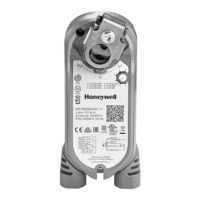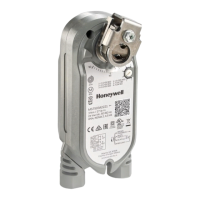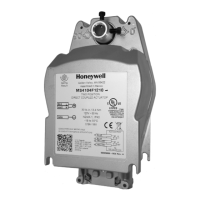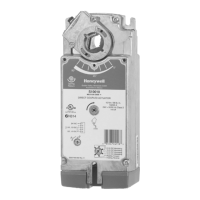3 NM, 5 NM SERIES SPRING RETURN DIRECT COUPLED ACTUATORS
11 62-0274—07
6. Apply control signal for actuator 0% position.
(See Fig. 11 and Table 2.)
a. (0)2-10 Vdc: apply (0)2 Vdc signal to terminal 3.
b. 10-(0)2 Vdc: apply 10 Vdc signal to terminal 3.
c. (0)4-20 mA: apply (0)4 mA signal to terminal 3.
d. 20-(0)4mA: apply 20 mA signal to terminal 3.
e. Floating: apply 24 Vac to appropriate 0°-90° (3) or
90°-0° (4) terminal.
7. Actuator drives to full open or full closed position.
Spring Return Operation
1. Mount actuator for required application (either clock-
wise or counterclockwise rotation to open
the damper or valve).
2. Connect power to terminals 1 and 2. (See Fig. 11 and
Table 2.)
NOTE: For two-position models skip to step 5.
3. Set “Mode Select” dial to desired control signal.
(See Fig. 4.)
4. Apply control signal for actuator 50% position.
(See Fig. 11.)
a. Vdc Input Signal: apply 5-6 Vdc signal to terminal 3.
b. mA Input Signal: apply 10-12 mA signal to terminal 3.
c. Floating: apply 24 Vac to appropriate 0°-90° (3) or
90°-0° (4) terminal until device reaches 50%.
5. Allow the actuator to drive to 50% position.
6. Disconnect wire from terminal 1.
7. Actuator spring returns to 0% position.
8. Re-connect wire to terminal 1, actuator drives back
toward 50% position.
Feedback Operation
1. Connect a multi-meter, set for Vdc, to terminals 2 and 5.
2. Apply the same signal as in step 4 of Modulating
Operation.
3. The multi-meter reading increases to match the input
signal as actuator drives towards full open or full closed
position.
4. Apply the same signal as in step 6 of Modulating
Operation.
5. The multi-meter reading decreases to match the input
signal as actuator drives towards 0% position.
Direct Checkout
1. Mount actuator for required application (either clock-
wise or counterclockwise rotation to open
the damper or valve).
2. Check damper position and make sure that 24 Vdc/Vac
is present at the appropriate connections. (See Fig. 9.)
3. Apply control signal to the appropriate connections to
move the damper to the opposite position. The actuator
should drive the damper or valve.
4. If actuator does not run, verify that the actuator is
properly installed for either clockwise or counter-
clockwise rotation.
5. If actuator is correctly installed and still does not run,
replace the actuator.
Two-Position Checkout
1. Mount actuator for required application (either clock-
wise or counterclockwise rotation to open
the damper or valve).
2. Check damper position and make sure that power is
present at terminals 1 and 2.
3. Actuator drives to 100% position.
4. Disconnect power from terminals 1 and 2.
5. Actuator spring-returns to 0% position.
If actuator is correctly installed and does not run, replace the
actuator.
Sylk-enabled (S-BUS) Checkout
1. Mount actuator for required application (either clockwise
or counterclockwise rotation to open the damper).
2. Connect Sylk-enabled (S-BUS) controller to terminals 3
and 4. (See Fig. 20)
3. Connect power to terminals 1 and 2. (See Fig. 20 and
Table 2.)
4. Set “Mode Select” dial to desired address (MS3105
series). (See Fig. 4.) This step is not necessary for the
MS3103 series.
5. Apply S-BUS command via the connected Sylk-enabled
controller for actuator full open or full closed position.
(See Fig. 20 and Table 2.) The MS3105 series has the
option for local test by setting “Mode Select” dial to 6.
Remember to reset the “Mode Select” dial to the appro-
priate address after the test has been completed.

